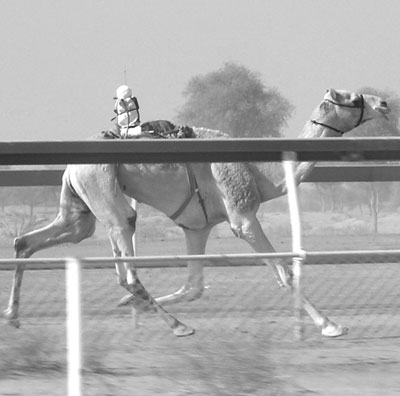Camel racing meets technology
I visited several countries in the Arabian Peninsula, including the United Arab Emirates, in early December ’05. One day in the northern emirate of Ras al Khaimah (locally known as RAK), I was traveling around in my hired car with driver when I spotted what looked like a racetrack near the community of Diqdaqa. I immediately thought “Camel racing!”
Throughout the Arabian Peninsula (especially in such oil-rich countries as Saudi Arabia, Qatar and the UAE), camel racing is the sport of sheikhs and has been popular for centuries. I had been hoping for a chance to observe this ancient tradition of the desert Bedouin.
I pointed out the track to my English-speaking Pakistani driver and asked him if there was going to be a camel race that day. He said that there was no camel racing in that area. I asked him to drive over to a road that paralleled the track. I saw camels and cars moving very fast around a bend and heading toward us. I rolled down the window so I could see better and also take photos while we sped along beside the camels. My driver called out, “No photos! The little boys! No photos!”
I told him it was okay, that the jockeys were not little boys; they were robots. In a moment it was all over and I explained to him. Fortunately, I had a digital camera and could prove what I told him by showing him the photos on my camera screen.
What we had witnessed was a camel race with robot jockeys strapped atop the camels. Each robot whipped its camel’s haunch with a whip attached to one “arm” while pulling on the reins with the other “arm.” All of this was controlled by the camel owners, who rode alongside in their SUVs and vans, wielding their remotes outfitted with the appropriate joysticks and buttons.
Just before I left the States, I had read an article in Wired magazine about the experimental use of robots to jockey racing camels in some Arabian countries. Basically, camels won’t race without a jockey, and the smaller and lighter the jockey, the faster the camel and the more likely the win.
For decades, the answer had been to use children as young as five to jockey the camels. These children were brought in from Sudan, Bangladesh and Pakistan and starved to keep their weight down around 40 pounds. Often, the children had been kidnapped or sold by their impoverished parents.
In 2003 the United Nations got wind of this trafficking in slavery and human rights abuse and threatened sanctions. In response, the UAE and several other Arabian countries banned the use of jockeys younger than 15 and/or weighing less than 100 pounds. As that would result in very slow camel races, Swiss manufacturers were contracted to develop a robot that could function as a lightweight jockey.
During the summer of 2005, robot-jockey prototypes were developed and tested. As it happened, the camels would not accept a rider that was not somewhat anthropomorphic (as they were used to), so the robots had to resemble little boys.
The early prototypes actually had little heads, wore sunglasses and caps and had painted faces! The prevailing religion, Islam, frowns on such human representations, however, so a delicate balance had to be achieved between making the robots human enough to be accepted by the camels and nonhuman enough to assuage the religious concerns of the imams.
Apparently, that balance had been attained by December when I watched the race. The robots I saw were shaped like small human bodies and had whips attached to arms, but they had no features or even faces. Interestingly, some of my photos do show caps on the robot jockeys’ “heads.” They had fooled my driver, who knew about the government’s prohibition and was afraid of my taking pictures of the practice.
ALISON KING
Laguna Beach, CA

